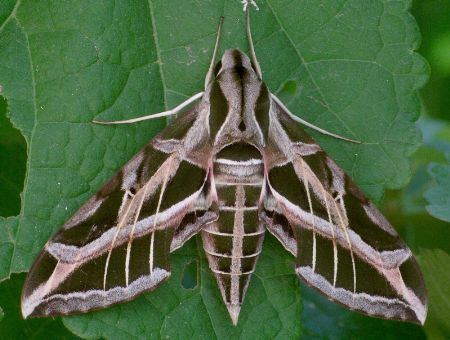by Valerie
July, 2008Vine Sphinx
The gorgeous moth featured this month is the vine sphinx (Eumorpha vitis), a species with a wingspan of over three inches. These moths hide during the day, venturing forth to feed at dusk. Sphinx moths, also called hawk moths, are rather long-lived compared to many other moth families, and a few species can be seen feeding at flowers during the day, as well as more commonly in the evening or early morning (it's sort of hard to see them at night). They have extremely long proboscises and can easily take nectar from large, long-tubed flowers such as jimsonweed (Datura inoxia) and trumpet vine (Campsis radicans). When encountered, sphinx moths are often mistaken at first for hummingbirds, and indeed some are the same size, and their wings blur in the same way when they fly. The larvae of sphinx moths are called hornworms, for the little pointed "tail" that most species have on their back ends. The name "sphinx" also comes from the larvae, which often raise and curl their head when disturbed, resembling the mythical creature. As expected for moths of this size, the caterpillars are equally big; the vine sphinx larvae reach over three inches in length before pupation. They feed on vines in the grape family, including ivy treebine (Cissus incisa) and mustang grape (Vitis mustangensis). |